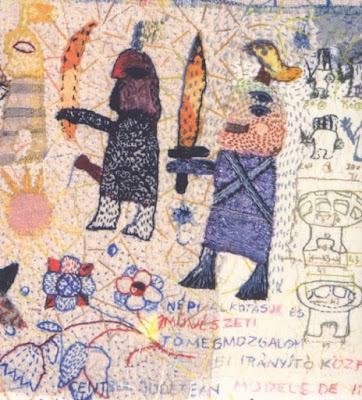The work I am so enamoured with is of course, her quilts. In this instance it's their embroidery/illustration and content that fascinates me rather than any technicalities of the craft. Their thinness, with warped sides remind me of early quilts that were perhaps made for hospital patients from newspaper or old shirt fabrics.
The works are huge in scale, intricate, complex, intimate, meaningful, playful, contradictory. Some of the images evoke for me the dynamism and movement of Cy Twombly. Each one is a place to visit, spend time, be lost, find things, learn and always be inspired. So many things happening in each piece, so many strands, stories and interpretations.. with a level of skill, care and detail that belies their playful appearance.
A number of years ago I wanted to find out more about Anna Torma, so I contacted her and asked where I might find information. Her response was to very kindly post me an exhibition catalogue in return for copies of Selvedge. I was thrilled and impressed by her earthy nature and open manner. It felt like a favourite pop star had written to me - so exciting.
This warmth is blatant in her work. Her maternal experience is there for all to see but she is a weighty artist, an important influence on many fibre artists. Her originality, questioning of materials, technical expertise, wisdom and cultural heritage are cleverly and delicately woven into the complicated patterns and subtexts.
Torma repeatedly uses the drawings and stories of her children. As I am primarily concerned with the use of textiles to communicate and perpetuate memory, I find this element of her work particularly powerful and moving. A simple rainy day stuck indoors, but the details of that are not just on film or in photos, instead expressed by the children and Anna through their markings and her stitch. The work involved feels like a natural representation of the patience and repetition of motherhood and the unconditional love therein.
Are the images we see portrayed here of stories she has shared with her children again and again, reminding them all of the nights she comforted them and rocked them to sleep? Do I see monstery teeth - so significant in early childhood - so painful yet such a bonding shared experience. The monsters and the landscapes.. I see an image of numerous breasts - is that of significance to Torma? Before I knew about Torma's work I used this image myself in a diary drawing many years ago when I was making a joking nod to feeling able to nurture the world (or something like that). Perhaps the many-breasted woman is one with love enough for all..? Was this Torma that was full of love or something significant to her children? The whole piece is a big, beautiful private code within which we can all find significant parts, beautiful hints and project our own hypotheses. All of it about emotion, about feeling and reacting, making us think and feel, to me it is what makes work powerful.
This warmth is blatant in her work. Her maternal experience is there for all to see but she is a weighty artist, an important influence on many fibre artists. Her originality, questioning of materials, technical expertise, wisdom and cultural heritage are cleverly and delicately woven into the complicated patterns and subtexts.
Torma repeatedly uses the drawings and stories of her children. As I am primarily concerned with the use of textiles to communicate and perpetuate memory, I find this element of her work particularly powerful and moving. A simple rainy day stuck indoors, but the details of that are not just on film or in photos, instead expressed by the children and Anna through their markings and her stitch. The work involved feels like a natural representation of the patience and repetition of motherhood and the unconditional love therein.
Are the images we see portrayed here of stories she has shared with her children again and again, reminding them all of the nights she comforted them and rocked them to sleep? Do I see monstery teeth - so significant in early childhood - so painful yet such a bonding shared experience. The monsters and the landscapes.. I see an image of numerous breasts - is that of significance to Torma? Before I knew about Torma's work I used this image myself in a diary drawing many years ago when I was making a joking nod to feeling able to nurture the world (or something like that). Perhaps the many-breasted woman is one with love enough for all..? Was this Torma that was full of love or something significant to her children? The whole piece is a big, beautiful private code within which we can all find significant parts, beautiful hints and project our own hypotheses. All of it about emotion, about feeling and reacting, making us think and feel, to me it is what makes work powerful.
Torma completed her studies in Hungary in 1979, having witnessed the textile revolution of the 1970's. Textiles was at that time moving away from it's incarnation as folk art, or genteel past time. It slipped under the harsh spotlight of the authorities that shone intently over the shoulder of fine arts. Pieces were then being woven or stitched into abtract forms, installations, conceptual work in ways that had not previously been considered.

detail from Playground I - 2002
Her work today seems to me to be entirely universal in it's communication of shared experiences, instincts and references. I'd really love to see it in person - to experience the scale, the texture, the little details, the motion of the stitch and the emotion of the piece. If any of you have experienced her work in person then please tell me - I'd love to hear about it.





























































